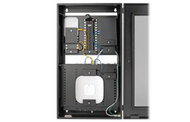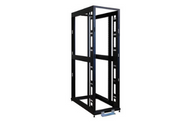Tripp Lite Racks & Enclosures
A server rack, also known as a server cabinet or data cabinet, is an essential piece of equipment utilized in modern data centers and other IT environments. Its primary function is to provide a secure and organized space for housing multiple servers, networking equipment, and other critical hardware components. By utilizing a server rack, IT professionals can ensure that their equipment is stored in a safe and efficient manner, allowing for easy access and maintenance. Additionally, server racks are designed to optimize airflow and cooling, which helps to prevent overheating and prolong the lifespan of the equipment. Overall, the use of a server rack is a crucial component of any well-designed IT infrastructure, providing a reliable and scalable solution for managing complex server environments. The rack enclosure is a highly standardized and meticulously engineered metal frame that boasts a plethora of mounting spaces, also known as U spaces, which are specifically designed to accommodate servers and other critical equipment. The primary function of this enclosure is to provide robust support and optimal protection to these devices, ensuring their longevity and uninterrupted performance. Server racks are available in a wide range of sizes and configurations to meet the diverse needs of businesses and organizations. These racks can be either free-standing or wall-mounted, depending on the specific requirements of the user. The choice of rack size and mounting option will depend on factors such as the number of servers to be housed, the available space, and the desired level of accessibility and security. Regardless of the chosen configuration, server racks are an essential component of any modern IT infrastructure, providing a centralized location for housing and managing critical computing equipment. In addition to their primary function of housing servers and other equipment, data center racks are commonly outfitted with sophisticated cable management systems that serve to both organize and safeguard the numerous cables and power cords that are required to interconnect the various components. These cable management systems are designed to minimize the risk of cable damage or disconnection, while also facilitating easy access and maintenance of the equipment housed within the rack. By implementing these advanced cable management solutions, data center operators can ensure optimal performance and reliability of their critical IT infrastructure. The consolidation of multiple servers into a single rack is a highly effective strategy that data centers and IT environments can employ to optimize their space utilization and enhance the overall efficiency of their operations. This approach involves the integration of several servers into a single physical unit, which not only helps to reduce the physical footprint of the infrastructure but also streamlines the management and maintenance of the system. By consolidating servers, organizations can achieve significant cost savings, reduce power consumption, and enhance their overall computing capacity. This approach is particularly beneficial for organizations that are looking to scale their operations while minimizing their physical footprint and maximizing their resources.











